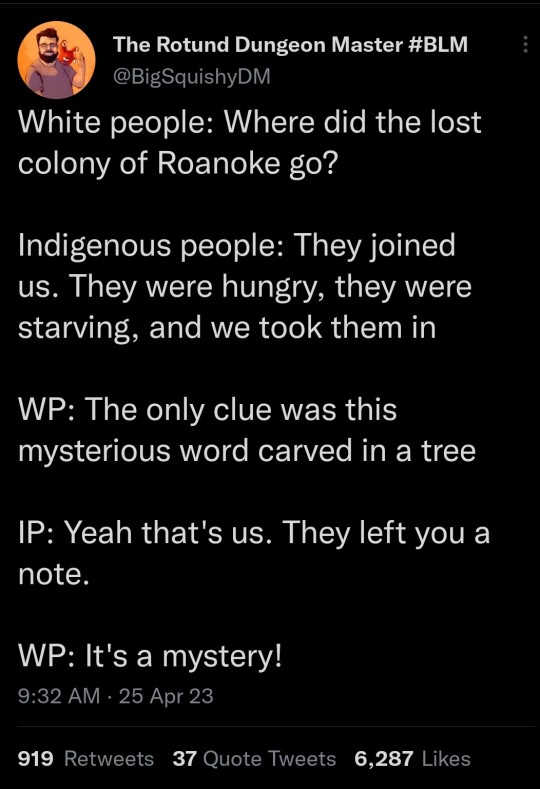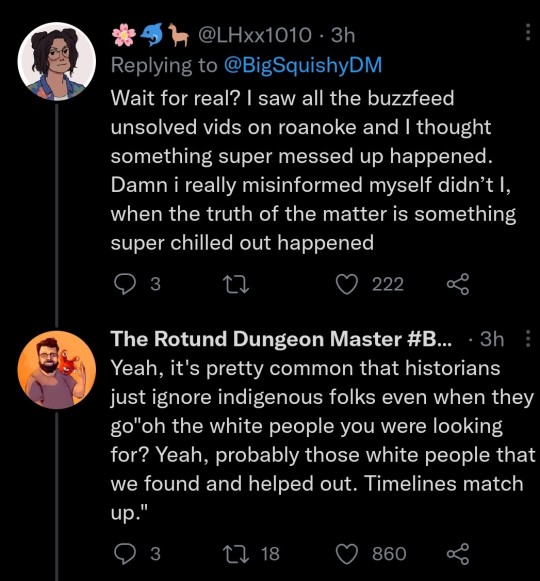#indigenous history
Explore tagged Tumblr posts
Text

Edward W. Gifford, Central Miwok Cat's Cradles, 1933
#my post#photography#b&w#native american art#indigenous history#1930s#yosemite#cats cradles#edward w gifford#miwok tribe
28 notes
·
View notes
Text
Okay, @thisonecassie, you want to be a cunt and a bigot so I'll give you the exact same energy back to you.
I'm not acting like a toddler, I answered your question perfectly politely and you didn't like the answer and now you're having a tantrum about it.
I see you're insistent on having the answer that includes personal trauma, so here it is: I celebrate it because Christians slaughtered my people if we refused to convert and wore our ears as necklaces to show off how many of us they'd killed (an actual thing that happened, I'm not being hyperbolic; we're taught about this in history class and shown primary sources about it).
So those of us who wanted to survive had to adapt to Cristian demands lest we be hunted down and massacred some more.
So you can't turn around and whine and bitch that you're the victim when y'all forced us to celebrate (upon pain of death) to begin with.
You know who celebrates secular Holi? Lots of people in India. I've never been there so I haven't experienced it but I absolutely would if I had the money to go there during the celebration.
You know who celebrates secular Hanukkah? My Jewish coworker who's atheist too. And all the other atheist Jews out there.
You know who celebrates secular Diwali? Indians as well as the kids at the school I teach at.
You know who's celebrated Festa Junina as a secular holiday? Me.
Just because YOU haven't personally experienced a religious celebration in a secular capacity doesn't mean the rest of us haven't, dimwit.
I hate to say it but I do fear we need to take Christmas away from non-Christians.
‘Secular Christmas’ babes that’s just capitalism…
#bigotry#unnecessarily agressive#christianity#religion#did you know#religious persecution#merry christmas#indigenous history#brazil#brazilian history#happy holidays#christmas#easter#xmas#merry xmas#ffs man#victim complex
83 notes
·
View notes
Text







3D Reconstruction of Tenochtitlán by Thomas Kole
#history#art#mesoamerica#archaeology#antiquities#mexico#aztec#indigenous#indigenous history#precolumbian#precolumbian art#tenochtitlan#my posts
10K notes
·
View notes
Text


Photos of Nancy Valverde, a Chicana gender nonconforming lesbian who was routinely arrested for violating L.A.’s cross-dressing ban throughout the 50s and has been credited as helping overturn the ban. Valverde died at the age of 92 in March of 2024.
#lgbt history#lesbian#wlw#lgbt#vintage lesbians#lesbian history#lesbian activist#Nancy Valverde#RIP#chicana history#indigenous history
3K notes
·
View notes
Text


11K notes
·
View notes
Text
Tribal Names
I don’t think many people, even some native people, are aware that the legal names of many tribes are actually not from the tribe.
Often the names came about because colonizers would ask one tribe "hey, what do you call those people over there?". then they would assign the name given to that tribe. so often the names were descriptions from unrelated tribes, or in more extreme cases, insults.
The Muscogee tribe got pretty lucky since the legal name was "creek" and it came from a different tribe going "oh, those are the people near the creek". which, is accurate enough, most creek settlements were placed along creeks. a famous one that is related to the Muscogee is the name "Cherokee". "Cherokee" is a Muscogee word meaning something along the lines of "people who don’t speak our language". Even this is pretty light compared to some names. some official tribal names translate to phrases like "dog eaters" or "lazy people".
This is why it’s not uncommon for tribes to start using older names. Muscogee comes from the term for our people "Mvskoke", and the tribe has made efforts to distance itself from the name "Creek". Although it is likely still the name you’ll hear most often.
#muscogee#mvskoke#native blogs#native american#indigenous blog#indigenous#native girls#indigenous history#muskogee#cherokee#oklahoma#native americans#tribal names#tribes#north american history#creek tribe
2K notes
·
View notes
Text

In celebration of Native American Heritage Month and Indigenous Peoples Month, we reflect on the deep history, resilience, and cultural richness of Indigenous communities.
Sharing these stories allows us to honor traditions and contributions that continue to shape our shared world. For those interested in learning more, JSTOR Daily has curated a collection that highlights Indigenous perspectives, art, and histories.
Image: Detroit Publishing Co. Pueblo Indian Woman with Olla. 1902. Trinity College, Watkinson Library.
#jstor#jstor daily#indigenous peoples month#native american heritage month#indigenous peoples#native americans#indigenous history#native american history
482 notes
·
View notes
Text




Celebrating Indigenous Peoples' Day!
Today the USA marks Indigenous Peoples' Day - to celebrate, have a listen to these podcasts to learn some of the Indigenous, queer history of what is now the USA.
Osh-Tisch
Osh-Tisch was a batée born in the mid-19th-century Crow Nation. Batée is a uniquely Crow gender identity, describing a person assigned male at birth, who performs female as well as specifically batée social roles. Osh-Tisch was renowned for their skills as a craftsperson, their bravery in the 1876 Battle of the Rosebud, and as the best poker player in the region. In the face of attempts by the US government to force assimilation to Western ideas of gender, Osh-Tisch’s community fought for their right to express their identity.
[Image source: Will Roscoe’s Changing Ones: Third and Fourth Genders in Native North America]
We'wha
Born c.1849 at Zuni (now in New Mexico), We’wha was a lhamana - a Zuni gender including both masculine and feminine roles. Like many lhamana, We'wha was a highly skilled craftsperson, proficient in both traditionally masculine, and traditionally feminie crafts. In 1885, We’wha travelled to Washington DC as a representative of the Zuni people, where they worked with anthropologists and the Smithsonian museum to demonstrate and share information about Zuni crafts and culture, and met US President Grover Cleveland.
[Image source]
Bíawacheeitchish
Born in the early 1800s, Bíawacheeitchish (Woman Chief) was a Gros Ventre woman who lived amongst the Crow people. She was skilled in traditionally masculine pursuits like riding, hunting and warfare. Polygamy was common amongst the Crow, and Bíawacheeitchish married four women. Her military prowess led to her becoming one of the most respected Crow chiefs.
[Image source]
Kapaemahu
According to Hawai'ian oral histories, in around the 1500s, four healers visited Honolulu from what are now the Society Islands. These healers - named Kapaemahu, Kahalao, Kapuni, and Kinohi, were māhū, a gender recognised in Kānaka Maoli (Native Hawai’ian) culture, with a particular focus on healing and caring roles.
When they departed Hawai'i, the four māhū left behind four huge stones as a memento of their visit, imbued with their healing powers, which are still revered in Hawai'i today.
[Image source]
#indigenous peoples day#indigenous history#crow history#hawaiian history#zuni history#queer history#two-spirit#two-spirit history#lgbt history#lgbtq#native american history
553 notes
·
View notes
Text

273 notes
·
View notes
Text

A passage from Reclaiming Two-Spirits: Sexuality, Spiritual Renewal & Sovereignty in Native America by Gregory D. Smithers.
[Image ID:
A photograph of a page from the book mentioned above, which reads:
"Language reclamation and renewal is key to understanding Two-Spirit storytelling. From Mesoamerica to sub-Arctic tribal communities, Native languages routinely avoided the use gender pronouns. Lakota speakers for example, tended to use the linguistically neuter "it" instead of gendered pronouns. Throughout Indian Country, distinctions of animate and inanimate, thing and person, human and more-than-human kinship, carried greater meaning than Western-style gender pronouns. The Hopi, who speak an Uto-Aztecan language, distinguish people and things not according to gender but according to the categories animate, inanimate and vegetable. Athabaskan speakers didn't historically use gender pronouns and as a consequence had what Europeans perceived as confusing gender distinctions. Among Dakota-speaking people, gender is understood in lots of different ways, but historically the language has never involved the use of gender-specific pronouns. And Iroquoian speakers, like the Cherokees, did not use gender-specific pronouns either.
These examples only scratch the surface of linguistic and cultural understandings of how Native Americans blended gender roles in and identities and engaged in sexual activity they considered normal and healthy. Traditionally, Indigenous people tended to avoid using anatomy or physical appearance as crude markers of gender. They developed much more complex social and cultural systems that made room for gender blending and sexual fluidity within kin-based communities.
The idea that an individual might blend multiple gender identities into their conception of self is an alien concept in virtually every Western culture. But when Europeans began invading the Americas during the late fifteenth century, most Native communities did not connect gender to to anatomical concepts of "sex" in the way we do today. Instead, Indigenous people blended occupational roles, physical characteristics and clothing, speech patterns and jewelry, and spiritual and... (text ends here)"
End image ID.]
#lgbtq#lgbt#two spirit#2s#lgbtq2ia+#queer#gender nonconforming#multigender#qpoc#indigenous literature#indigenous history#our pics#queer history#resources#reference
188 notes
·
View notes
Text
Sámi artist Mari Boine joiking the village Máze.


[ID: 1: Sámi activists in gáktis (traditional clothing) holding a banner that says “we came here first” in norwegian. A banner in the background says “we will NOT move”. 2: sámi man in gákti standing with his fist raised in front of big stones that have the word “let the river live” painted on them]
Joik is a type of traditional sámi singing that’s meant to evoke/express a person, animal or place through rhythm, sounds and energy. You don’t joik about someone, you joik them. Joik is mostly sounds, and often have no lyrics or short lyrics. “Máze” has lyrics calling Máze beautiful and saying “Under water they would put Máze church, Máze school”, which is referring to the Alta conflict in the 1970s and 80s.
Máze is a small village on the norwegian side of the borders in Sápmi. Around 98% of the population is sámi. In the late 1960s, the Norwegian government announced plans to build a hydroelectric power plant and dam in the Alta river, which would have huge consequences for sámi reindeer herding and fishing in the area, preventing sámi people from continuing to practice their traditional way of life. The earlier plans for the dam would have put Máze under water, displacing all the people living there and destroying a village that has existed for hundreds of years. After resistance from sámi activists, the plans were altered in 1973 so that Máze would survive.
Sámi people fought against the construction of the power plant for years, with protests, peaceful civil disobedience (like chaining themselves and creating blockades around the site), and a hunger strike where they slept in lávvus in front of the norwegian parliament in 1979, and a second hunger strike in 1981. 10% of the norwegian police force was sent to the construction area and there was talk of sending the military to assist the police, but this was stopped by the minister of defense at the time. several hundreds of people were removed by force from protests and arrested.
The Alta hydroelectric power plant was finished in 1987 and is still in operation. This is one of the most famous examples of Norway’s green colonialism in Sápmi, but it’s also one of the biggest examples of Sámi spirit and resistance. Máze continues to exist, more than 50 years later. Sámi people are still here and we’re still fighting for our right to continue our traditional lifestyles and culture, for example with the large civil disobedience actions in 2023 over the Fosen case.
Čájet Sámi Vuoiŋŋa! show sámi spirit! ❤️💚💛💙
337 notes
·
View notes
Text
Time Travel Question 57: 19th Century
These Questions are the result of suggestions from the previous iteration.
This category may include suggestions made too late to fall into the correct grouping.
Please add new suggestions below if you have them for future consideration.
#Time Travel#Tȟuŋkášila Šákpe#Indigenous history#US History#Paris Exhibition#Victorian#Fancy Dress Ball#The Statue of Liberty#Benjamin Waterhouse Hawkins#Iguanodon Dinner 1854#The Crash at Crush#Herman Melville#Nathaniel Hawthorne#Bram Stoker#Walt Whitman#Astor Place Riot#Pirate Queen Zheng Yi Sao#Ching Shih#Pirates#Chinese History#Beau Brummell#Frankenstein#The Vampyre#Mary Shelley#John William Polidori#Lord Byron#Percy Shelley#Percy Bysshe Shelley#Claire Clairmont
233 notes
·
View notes
Video
tumblr
California genocide
https://en.wikipedia.org/wiki/California_genocide
https://en.wikipedia.org/wiki/Bloody_Island_massacre
https://en.wikipedia.org/wiki/Round_Valley_Settler_Massacres_of_1856%E2%80%931859
#tiktok#california#history#indigenous#genocide#indigenous history#us history#19th century#1800s#california history#standford university#wealth
2K notes
·
View notes
Note
As a proud Jew and a member of the Iŋalit Iñupiaq people I have never felt as seen as reading a Choctaw Jew's post on here. Christian missionaries hauled my people off of our lands and killed most of us and they didn't even inhabit the land. They didn't even build shit there, they just took it to take it, and I'm supposed to go "ah yes America has no colonizers" and not laugh when these people say "Hebrew is a colonizer language"? Motherfuckers, MY LANGUAGE IS EXTINCT BECAUSE OF YOU! You know who didn't ever try and force a language on anyone? The Ashke Jewish man my great-great grandmother fell for and married. People really expect me to be onboard with their fact-free zero colonialism rewrite of history while my people's lands remain off limits to us, illegal to even visit, the US government holding onto it on the off chance there might be oil there even though they never bothered to even drill for it in over 70 years.
"No other religion acts like this" first of all please read up on Islamic imperialism and get your boot off the neck of my indigenous Middle Eastern brethren and secondly Christian-governed Alaska wouldn't let Native students attend school with "American" children - that is literally how the law phrased it - unless we abandoned our language, our clothes, our songs, our stories, our religion and even traditions as basic as sharing food with poor families in the community. You wanna know how my great-great grandmother met my great-great grandfather? They were both arrested for violating the law and "indoctrinating" children into "Native, anti-European practices" by which I mean THEY WERE BOTH ARRESTED FOR GIVING FOOD TO POOR PEOPLE. They were both arrested by CHRISTIANS!
And people mistake my brown skin for proof of goy status and want to talk shit about how the only good colonizer is a dead colonizer. You're white and you're in ALASKA, you might want to rethink the words coming out of your mouth when most of your ancestors came here to mine gold and get rich and mistreat indigenous people. Even if I accepted the idea that Israel is doing colonialism, which I do not, nobody moved to Israel to get rich and rape indigenous women with impunity to the point where there are words in Inuit languages for gangrape done by white men.
I don't want to hear another thing from a white goy in Alaska about Israel being colonizers when the US bought Alaska from Russia. We were colonized twice for you to get to be here and tell me to my face how colonizers are bad. AND THEN people want to say my Ashke ancestors were colonizers. Fleeing Russia is not colonization, one, and two, WHY DO YOU THINK THEY LEFT?! For fun? What, they heard our weather was nice and wanted to come visit?
I am going to need white goyim to learn US history before they open their mouths.
I'm sorry this is long and I yelled/capslocked but I have had to bite my tongue so many times to not cause a scene because I don't want the university to come up with an excuse not to let me graduate due to poor conduct. It is so tiring. I feel like I'm holding my breath all the time. Graduation is tomorrow. Shabbat shalom.
.
220 notes
·
View notes
Text
Iroquoian Wooden Armor
by Malcolm P.L.
An interesting series of videos where this gentleman researches, then constructs a set of replica wooden armor as used by the Iroquois before European contact.
Part I : Introduction
youtube
Part II : Overview
youtube
Part III : Thoughts on the Back Shield
youtube
Part IV : Socio-economics of Iroquoian Armor
youtube
Part V : The Iroquoian Shield
youtube
159 notes
·
View notes
Text
Ledger art and indigenous cultural continuity

Wooden Leg's ledger book, 1879-1881
Ledger art is part of a long tradition of Native people documenting their history on their own terms. Many Plains Native communities started chronicling events pictorially on materials like rocks and buffalo hides. Beginning in the mid-19th century, they used pages of ledger books obtained from settlers.
An example of adaptation and agency, ledger art is deeply embedded in the sociopolitical context of a given time. In the face of mass removal, assimilation efforts, and other genocidal actions taken by the U.S. government, Native communities found ways to continue observing their traditions and cultural practices using what was around them––in this case, repurposing found pages of ledger books when materials like buffalo hides became scarce.
Depicting everything from scenes of warfare to courtship, ledger art books tell readers about the memories, values, and presence of the communities who authored them. The images are drawn with a variety of materials, including colored pencils, crayons, and ink...
Read the full post at newberry.org

Black Horse ledger, 1877-1879
95 notes
·
View notes